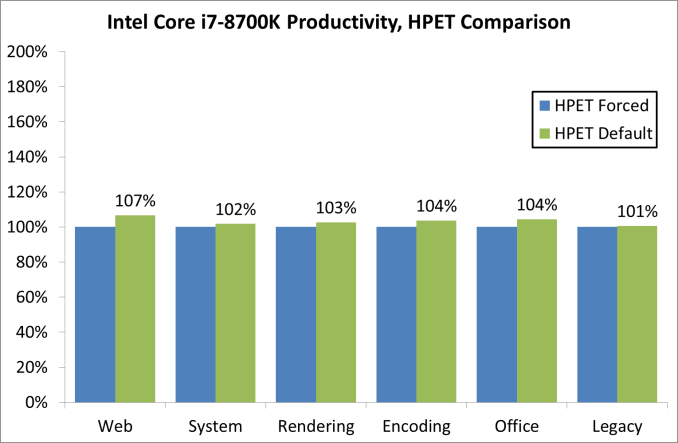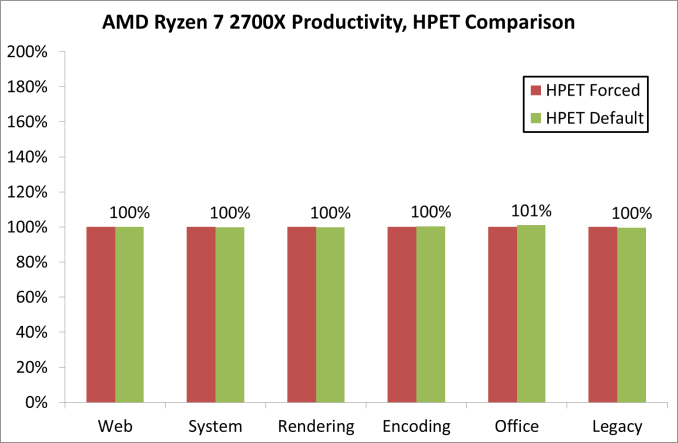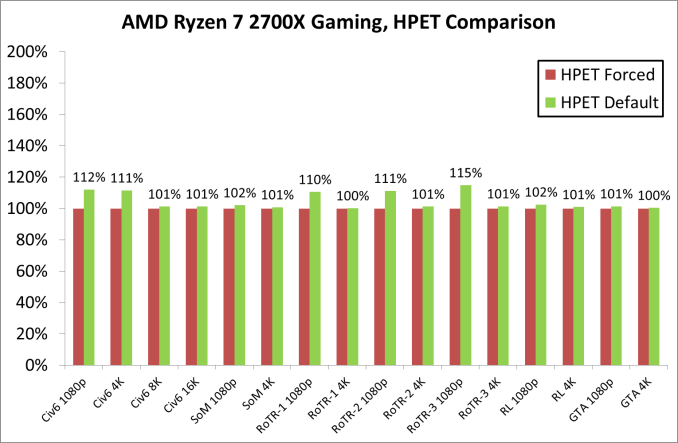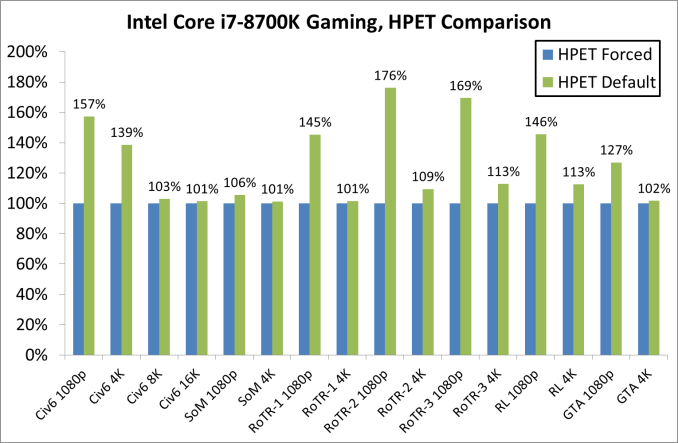A Timely Discovery: Examining Our AMD 2nd Gen Ryzen Results
by Ian Cutress & Ryan Smith on April 25, 2018 11:15 AM ESTForcing HPET On, Plus Spectre and Meltdown Patches
Based on my extreme overclocking roots back in the day, my automated benchmark scripts for the past year or so have forced HPET through the OS. Given that AMD’s guidance is now that it doesn’t matter for performance, and Intel hasn’t even mentioned the issue relating to a CPU review, having HPET enabled was the immediate way to ensure that every benchmark result was consistent, and would not be interfered with by clock drift on special motherboard manufacturer in-OS tweaks. This was a fundamental part of my overclocking roots – if I want to test a CPU, I want to make certainly sure that the motherboard is not causing any issues. It really gets up my nose when after a series of CPU testing, it turns out that the motherboard had an issue – keeping HPET on was designed to stop any timing issues should they arise.
From our results over that time, if HPET was having any effect, it was unnoticed: our results were broadly similar to others, and each of the products fell in line with where they were expected. Over the several review cycles we had, there were a couple of issues that cropped up that we couldn’t explain, such as our Skylake-X gaming numbers that were low, or the first batch of Ryzen gaming tests, where the data was thrown out for being obviously wrong however we never managed to narrow down the issue.
Enter our Ryzen 2000 series numbers in the review last week, and what had changed was the order of results. The way that forcing HPET was affecting results was seemingly adjusted when we bundle in the Spectre and Meltdown patches that also come with their own performance decrease on some systems. Pulling one set of results down further than expected started some alarm bells and needed closer examination.
HPET, by the way it is invoked, is programmed by a memory mapped IO window through the ACPI into the circuit found on the chipset. Accessing it is very much an IO command, and one of the types of commands that fall under the realm of those affected by the Spectre and Meltdown patches. This would imply that any software that required HPET access (or all timing software if HPET is forced) would have the performance reduced even further when these patches are applied, further compounding the issue.
It Affects AMD and Intel Differently: Productivity
So far we have done some quick initial re-testing on the two key processors in this debate, the Ryzen 7 2700X and Intel Core i7-8700K. These are the two most talked about processors at this time, due to the fact that they are closely matched in performance and price, with each one having benefits in certain areas over the other. For our new tests, we have enabled the Spectre/Meltdown patches on both systems – HPET is ‘on’ in the BIOS, but left as ‘default’ in the operating system.
For our productivity tests, on the Intel system, there was an overall +3.3% gain when un-forcing HPET in the OS:
The biggest gains here were in the web tests, a couple of the renderers, WinRAR (memory bound), and PCMark 10. Everything else was pretty much identical. Our compile tests gave us three very odd consecutive numbers, so we are looking at those results separately.
On the AMD system, the productivity tests difference was an overall +0.3% gain when un-forcing HPET in the OS:
This is a lower gain, with the biggest rise coming from PCMark10’s video conference test to the tune of +16%. The compile test results were identical, and a lot of tests were with 1-2%.
If Affects AMD and Intel Differently: Gaming
The bigger changes happen with the gaming results, which is the reason why we embarked on this audit to decipher our initial results. Games rely on timers to ensure data and pacing and tick rates are all sufficient for frames to be delivered in the correct manner – the balance here is between waiting on timers to make sure everything is correct, or merely processing the data and hoping it comes out in more or less the right order: having too fine a control might cause performance delays. In fact, this is what we observe.
With our GTX 1080 and AMD’s Ryzen 7 2700X, we saw minor gains across the board, however it was clear that 1080p was the main beneficiary over 4K. The 10%+ adjustments came in only Civilization 6 and Rise of the Tomb Raider.
Including the 99th percentile data, removing HPET gave an overall boost of around 4%, however the most gains were limited to specific titles at the smaller resolutions, which would be important for any user relying on fast frame rates at lower resolutions.
The Intel side of the equation is where it gets particularly messy. We rechecked these results several times, but the data was quite clear.
As with the AMD results, the biggest beneficiaries of disabling HPET were the 1080p tests. Civilization 6 and Rise of the Tomb Raider had substantial performance boosts (also in 4K testing), with Grand Theft Auto observing an additional +27%. By comparison, Shadow of Morder was ‘only’ +6%.
Given that the difference between the two sets of data is related to the timer, one could postulate that the more granular the timer, the more the effect it can have: on both of our systems, the QPC timer is set for 3.61 MHz as a baseline, but the HPET frequencies are quite different. The AMD system has a HPET timer at 14.32 MHz (~4x), while the Intel system has a HPET timer at 24.00 MHz (~6.6x). It is clear that the higher granularity of the Intel timer is causing substantially more pipeline delays – moving from a tick-to-tick delay of 277 nanoseconds to 70 nanoseconds to 41.7 nanoseconds is crossing the boundary from being slower than a CPU-to-DRAM access to almost encroaching on a CPU-to-L3 cache access, which could be one of the reasons for the results we are seeing, along with the nature of how the HPET timer works.
There is also another aspect to gaming that does not appear with standard CPU tests: depending on how the engine is programmed, some game developers like to keep track of a lot of the functions in flight in order to either adjust features on the fly, or for internal metrics. For anyone that has worked extensively on a debug mode and had to churn through the output, it is basically this. If a title had shipped with a number of those internal metrics still running in the background, this is exactly the sort of issue that having HPET enabled could stumble upon - if there is a timing mismatch (based on the way HPET works) and delays are introduced due to these mismatches, it could easily slow down the system and reduce the frame rate.














242 Comments
View All Comments
lenghui - Thursday, April 26, 2018 - link
Sounds like it's time to dig out that good old stopwatch from storage.haplo602 - Thursday, April 26, 2018 - link
And when MS changes HPET default to forced if detected ... then you are screwed again and have to retest ...You are at a dead-end actually. You are switching to HPET off (effectively) because it highly favors Intel in a few benchmarks yet AMD is mostly unaffected. Will you change that if the tables turn in the future again ?
Come on ... it is more about consistency. Your HPET forced mode definitely highlighted an issue with Intel chips yet instead of hitting on Intel about the issue you are changing your settings ...
Maxiking - Thursday, April 26, 2018 - link
"when MS changes HPET default to forced if detected"" if games start utilizing more cores "
It is a though job being an AMD fan these days, just "ifs" and "whens" all the time.
Maxiking - Thursday, April 26, 2018 - link
***tough***. damn you, autocorrecteva02langley - Thursday, April 26, 2018 - link
He's entirely right. HPET is an issue on Intel shoulder as of now. How can we be sure that without HPET on, Intel benchmarks are accurate?Also, you cannot turn off something in the BIOS that is supposed to be on, as mention by Intel, just because you want to give the crown to one manufacturer or the other. By the way, we are talking about 1080p benchmarks with a 1080 GTX. 60 Hz is irrelevant since a RX 580 can render it, it leaves only 1080p @ 144Hz.
Also, what about new games since these results seem to be linked to old games?
You don't get 40% more performance by switching something on and off in the BIOS. If it does, than something needs to be fixed.
RafaelHerschel - Thursday, April 26, 2018 - link
Well, I once disable my boot drive in the BIOS and experienced a 100% slow down. I'm tempted to agree with you and feel that something needs to be fixed so that my system works without a boot drive, but other people don't seem to agree. Opinions...Then there is the time when I disabled my NVDIA GPU in the BIOS of my laptop. Massive performance drop in games... Not good. Sad. Needs fixing.
jor5 - Thursday, April 26, 2018 - link
tl;dr - "We completely screwed up our review and made a show of ourselves - but we're not apologising"AndrewJacksonZA - Thursday, April 26, 2018 - link
You don't analyze data much in your day job, do you?SkyBill40 - Friday, April 27, 2018 - link
What would be more accurate than your statement is something like:"We found that our previous data contained some pretty significant inaccuracies and to be thorough, we're re-testing and improving our testing methodologies as a whole and explaining as such at length for the sake of transparency.Thanks for being patient with us."
OrphanageExplosion - Thursday, April 26, 2018 - link
What I don't understand is how the original gaming data ended up being published at all.The faulty results that were published were entirely at odds with the data supplied by AMD itself (which we've all seen - even prior to the reviews dropping, if you've been following the leaks). Surely if Ryzen 2000 was so much faster than Coffee Lake, they would have been shouting this from the rooftops - gaming is, after all, one of the few weaknesses Ryzen has. AMD's no-doubt massaged results were a ton more accurate than Anandtech's - madness.
Not only that but the Anand results showed a massive increase over Ryzen 1000 - which simply isn't feasible for what is effectively a mild refresh. Meanwhile, the results also showed Ryzen 5 handily beating an 8700K... surely you must have realised that something wasn't right at that point? Utterly baffling and calls into question your approach generally.
This is a major hit to credibility. I mean, if you're going to publish a CPU 'deep dive', surely you need to actually analyse the data and be ready to question your results rather than just hitting the publish button?